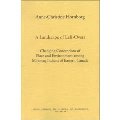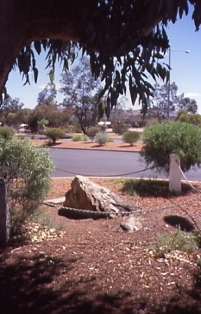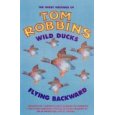Part II of Animism: Respecting the Living World is made up of four chapters of ethnography or case studies. These are rooted in guesthood (a method that celebrates the authority and rights of those whose knowledges and lives are discussed — and also celebrates the participative presence of the researcher).
This page provides some illustrations for those chapters, but its main purpose is to expand on the book by pointing to more ethnography, i.e., further discussions of animism. Some of these will be suggestions about articles and books to read, others will be links to websites.
Contents
Illustrating the case studies in my book
Mi’kmaq of Miawpukek (Newfoundland) - a photo essay
More about the phrase "other than human persons"
Drawing attention to Alan Campbell and the Wayapí
|
My book does not contain photographs or visual illustrations so I'm providing some here along with links to websites and other resources honouring those involved. |
|||
| illustrating Chapter 2: Ojibwe |  |
||
| illustrating Chapter 3: Maori | 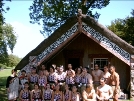 |
||
| illustrating Chapter 4: Aboriginal Australians |  |
||
| illustrating Chapter 5: Eco-Pagans | |||
Mi’kmaq of Miawpukek: a photo essay
| In July 1996 I was privileged to participate in a conference on "traditional healing and health" organised by medical anthropologists (especially John Crellin) at the University of St. Johns, Newfoundland, and hosted at the Miawpukek Reserve. The conference was followed by the Miawpukek Mi’kmaq Band's first "traditional, non-competitive pow wow". | 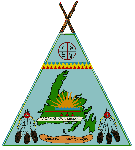 |
||
| The Reserve comprises an area alongside the Conne River in the south of the island, known to the Band as Ktaqmkuk. | 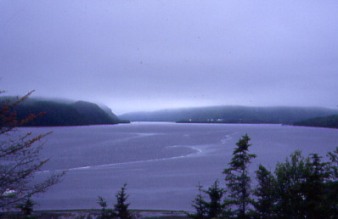 |
||
 |
 |
||
| Band offices | Habour | ||
| On a promontory to the north side of Miawpukek, an area had been prepared for the powwow and for accompanying sacred ceremonies, including four sweat lodges. | 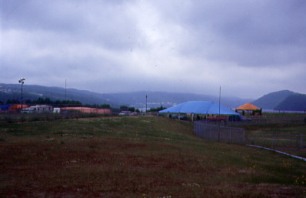 |
||
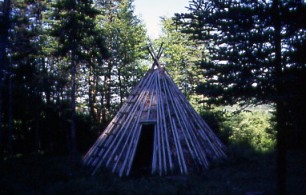 |
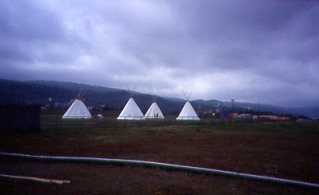 |
||
| It had been intended that guests would stay in traditional style homes, but they weren't ready, especially as heavy rains arrived. | So a group of tipis were provided near the dance grounds | ||
 |
 |
||
| elders, veterans, and other dancers circled around the drum groups | Lakota, Cree and other First Nations dancers joined local people and guests | ||
| Encouragement of respect included signs like this |  |
||
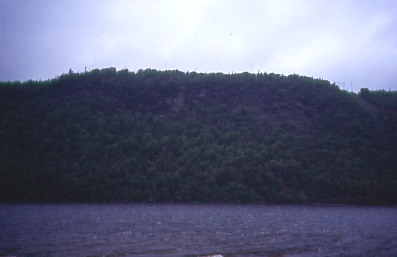 |
Across the river from the sweat lodges and the powwow circle, a wooded ridge provided a vantage point from which eagles watched. In addition to eagles, I'm told, the "little people" live in that hill. As elsewhere, I was given the impression that they aren't little ... but the person who mentioned them immediately went to the shore and spoke privately and respectfully to them. |
||
On the final day of the powwow, as the last round of the last honor song was being danced, the largest of the eagles flew over from its vantage point, a tree on that ridge. It flew a circle precisely over the powwow circle and returned to its tree.
Even those who live along Conne River, who see these eagles every day, stopped, looked up and exclaimed "eagle" or "kitpu" or whatever their name for this kind of person is. Everyone I talked with later spontaneously celebrated this as a significant, deliberate affirmation by the eagles that it was good to see humans returning to respectful, sacred and traditional ways.
It is not that Miawpukek is witnessing a "revitalization movement" because, several people told me, tradition had never gone away: the eagles, bears and salmon had maintained the respectful "good life" and had been waiting for humans to join in again.
The eagle's flight was not a random event but a deliberate action affirming what had been happening.
This is animism: the active, respectful relating of persons of various kinds who are part of a community. Maybe it is "totemism" too, in the way Debbie Bird defines it as "non random relations of mutual care" or a commitment to and concern for the "flourishing in the world" of those one is bound to, whatever their species. (See pp. 167-8 of Animism: Respecting the Living World for discussion and reference to Debbie's excellent and important work.)
I have no pictures of the eagle's flight because I was dancing and because I don't take pictures of people doing sacred things like flying in circles to honour sacred dancers.
This will probably be quite random until I gather a whole lot more and then I'll begin editing some structure into it ...
| The March 2006 issue of the journal Ethnos (7.1) has a set of important and excellent articles on animism. | Click here for more info | 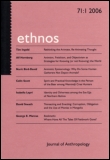 |
||
| Anne-Christine
Hornborg.
2001. A
Landscape of Left-Overs: Changing Conceptions of Place and Environment
among Mi’kmaq Indians of Eastern Canada. Lund Studies
in History of Religions, vol. 14, Lund: Almqvist och Wiksell International. |
This is particularly good not only because it develops ideas about animism drawing on similar sources to those I cite, but more so because it demonstrates the value of indigenous, traditional, contemporary animism to concerns and confrontations with modernist barbarisms such as mining and the destruction of places and people. | |||
| Andy Letcher. 2006. Shroom: A Cultural History of the Magic Mushrooms. London: Faber and Faber. | Certainly not all about animism, but an excellent and engaging cultural history ... well, what it says on the cover. But it does include discussion of animist engagements with mushrooms. See the website, buy the book |
|||
| Debbie Rose: In addition to Debbie's works already cited in my book, see her essays "Dingo Prayers", Island 103 (2005) 7-10; and "What if the angel of history were a dog?", Cultural Studies Review 12.1 (2006): 67-78. | These powerful essays blend nature writing, environmentalism, ethics, philosophy and so much more. Debbie is also central to the Ecological Humanities section of the Australian Humanities Review
|
|||
| Philippe Descola. 1993. The Spears of Twilight: Life and Death in the Amazon Jungle. New York: The New Press. | an impressive book that not only provides information about Achuar animism, shamanism, worldviews, lifeways, etc., but also sets an interesting example of how to write ethnology. |
A brief additional note about Hallowell's phrase "other than human persons"
I'm not alone in finding Hallowell's phrase - rooted in his learning from the Ojibwa of Beren's River - powerful, evocative and invaluable. However, although it is clearly a vast improvement over phrases like 'non-human' or 'superhuman', it might not be entirely accurate. Hallowell's phrase might intervene detrimentally between the members of Ojibwe clans (totems), which are interspecies kin groups (i.e. given associations of human and other-than-human persons such as beavers or bears). It might suggest that all humans are alike in a way that is not clear in these clan relationships. If the Ojibwe are Anishinaabeg, 'persons', they might question whether other humans, even other indigenous humans, are 'persons' in the same, fully relational, way. Similarly, Amazonian 'persons' might include jaguars and anacondas before it includes the humans down the road. If the term 'person' is relational and key to the whole project of animism, it is also contested by the possibility of non-relationship. If the Jivaro are not 'persons' to the Wari but anacondas are (as might be the case, I'm not sure), then Hallowell's phrase needs care. Just as Europeans wondered about the humanity of most (?) of the 'others' they encountered in their colonial expansion, so indigenous peoples often privilege the personhood of themselves in contrast to the less certain or decidedly negative status of their 'others'.
This is not a rejection of Hallowell's phrase, nor a new thought, but a refinement of a point already made by Hallowell and others who've found the phrase useful. That is, the phrase is necessarily relational: it is only useful in conversation with other humans. If there are human- and other-than-human persons there are also eagle- and other-than-eagle persons. But IF, and this is the point, some humans are uncertain about the personhood of some other humans, then perhaps we need to drop the word 'human' and talk instead about specific Ojibwe- and other-than-Ojibwe persons ...
Nonetheless, to resonate with comments I've already made in my book (albeit briefly), the chief value of Hallowell's phrase is in teaching us to pause each time we say 'person' and wonder if we are unduly privileging humans. I remain unconvinced by those who have tried to persuade me (in the nicest possible way, usually) that 'person' IS a primarily a reference to humans and only works as a projection or by extension to animals and so on. I continue to think that 'person' means a relational being, or a being who is relating, an actor or agent in communicative encounters with other beings who respond, sometimes reciprocally, sometimes violently, but always relationally. If 'person' means this (well, I insist that it does, but I'm a fan of Humpty Dumpty linguistics) then it only refers to humans when they/we are actively relating too. 'Person' does not refer to interiority (as the devotees of Western epistemology and ontology might assert) but to relationality.
Drawing attention to Alan Campbell and the Wayapí
I cite and discuss Alan Campbell's ethnography of the Amazonian Wayapí, especially his chapter 7, "Submitting". I also included a reprint of the chapter in my Shamanism: a Reader (London and New York: Routledge, 2003). But I've just re-read it and been moved by the following statement that develops Godrey Lienhardt's explanation that different beliefs to our own might be no less reasonable. Campbell writes:
“It isn’t so much the particular [shamanistic or, better, animistic] beliefs that are incomprehensible to us. It’s not that they were ‘animists’ and we are not. The difficulty is rather than we have, for ourselves, through the material conditions of our lives and the relation with the natural world that comes from that, make their kind of relation with the animals and the trees and the waters profoundly incomprehensible.”
This is paralleled in Ronald Hutton's review of my Shamanism Reader when he says that it
"poses, in its starkest form, the biggest question that hangs over modern Western scholarship: whether it is, in fact, the work of a particular tribal culture, committed to its own, subjectively effective, views of the cosmos, or whether it has the responsibility for creating some kind of universal explanatory structure for all humanity. The historic problem is that it is actually designed to be the former, and is struggling to be the latter." (Times Higher Education Supplement, 9 May 2003. p.25).
The question isn't whether "they" (animists or any other of modernity's "others") are rational or not. It is whether we have wrongly constructed somewhere for ourselves that alienates us. In fact, we do live in the same, relational world as animists. We show that in all sorts of ways. Bruno Latour's insistence that We have never been Modern (New York: Harvester Wheatsheaf, 1993) indicates the incredible effort put into constructing and maintaining the illusion that modernism is a natural phase, modernity. So, I think Campbell overstates his case, animism is far from incomprehensible to us IF (a big if) we permit ourselves to step out of our self-constructed environment and realise that we are already part of a different world. This isn't about a nature/culture dualism (that's part of the delusion we've convinced ourselves to accept, for the most part, when we're working hard to keep the illusion going). Its about living in a world where humans are such full participants in the world that (a) our terms "society" and "culture" must cease appearing to exclude most of our experience, and (b) we act on our existing knowledge that everything we do is already a participation. We cannot, in the real world, throw things "away" because there is no "away". (Didn't Ursula LeGuinn say that?). We cannot, in the real world, pollute eco-systems with impunity. Our society already includes animals, plants, microbes, seasons, minerals, weather systems ... and the whole profligate abundance of it all.
Certainly all this is contrary to Tylor's project by which ethnography would enlighten the world by destroying primitive errors ...
In Wild Ducks Flying Backward Tom Robbins includes a poem called "Stick Indians" that has a line, "roadkill for their totems".
While he was writing about (imagined) alienation from a world that is far from controlled, subjugated, passive, conquered ... I wonder if the truth is that it is not the rumored, elusive "Stick Indians" whose totems are roadkill but us.
one badger discarded among others by a country lane,
Spring
2008
Roadkill are our close kin. They most closely share with us and reveal to us (if we'll notice) the world we are creating. Our "pets" and "companion animals" typically only share the cozy bits of our lives. Roadkill are our clan kin. They presage the end of the road we are traveling.
In Animism I note that "totemism" should be revisited (following in the wake of "animism" and "shamanism") and that Debbie Bird leads the revisitation that reclaims indigenous knowledges and relationships and insistently reveals their relevance and challenge to the (fictive / colonizing) project of modernity. In a throw away world, what is not disposable? Among those who imagine themselves to be aliens transcending their environment as actors posturing in front of scenery, what is inalienable? What belongs?
I realise this isn't objectivity, but understanding requires participation.
Last updated 24 February 2008

| Return to animism homepage | |
| Animist Realism | |
| Narrow Animism | |
| Panpsychism and Hylozoism | |
| Post-dualism | |
| you
are here |
More Ethnography |
| Living it | |
| Animation and projection | |
| Wights and other persons | |
| Shamans and animists | |
| Darwin's animism | |
| Animist Manifesto |
|
|
Click here for Pilip Jeddore's Miawpukek site - with local news, views, persons and more
Click here for what the Department of Indian Affairs and Northern Development has to say, and for census data.
Click here for Miawpukek crafts
And click here for another Mi'kmaq band's site.
for another account of the conference and powwow - and a mention of eagles - click here
Robbins, 2005: 146.
